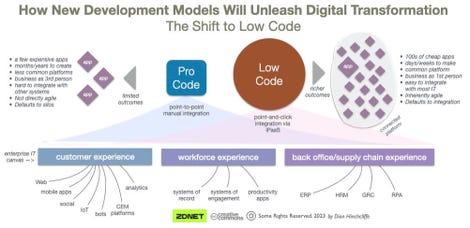Low code, once relegated to the less respected fringes of the development tools industry, has re-emerged in recent years as an increasingly efficient technology, which allows users to create software applications without needing to write much. of code. Or hire professional developers.
I’ve considered low code a major trend for years. But it is only today that it imposes itself. Mature companies in this category, such as Microsoft Power Platform and Appian, show that this technology is both very sophisticated and has a real capacity to last.
Today, low code is often used by business users to create and customize the business applications they need. And it’s faster and easier than they can get it from their CIO or an external partner.
In my experience, low code allows more and more to create credible entire applications and can bring real added value. And this with little or no involvement from a coder and minimal review from the IT department. This, as we will see, is part of the reason why low-code tools for the enterprise address the most common concerns, for example, data security or application lifecycle management.

Dion Hinchcliffe/ZDNET
What is the true value proposition of low code today?
On paper, “low code” solutions have something to please. My research has shown me that companies and IT departments are increasingly using “low code” technology because it has a number of specific advantages, including:
- The acceleration of development. Low-code platforms allow users to build applications faster and easier than traditional means, without the need to write complex code. This can dramatically reduce the time it takes to develop and deploy new business solutions, allowing organizations to respond more quickly to changing needs and stay competitive.
- Improved collaboration. Low-code platforms often offer a visual, drag-and-drop interface that allows non-technical users to easily contribute to the development of software solutions. This can improve collaboration and increase the participation of business users in the software development process.
- Greater flexibility. Low-code platforms allow organizations to create custom solutions tailored to their specific needs. They can also be used to integrate other systems, such as databases and APIs, to create a cohesive and flexible IT ecosystem.
- Cost reduction. Low-code technology can reduce the need for specialized and expensive IT resources, as well as external developers, which translates into cost savings for businesses.
- Easier maintenance. Applications developed using a low-code platform can be easily updated and maintained, due to their visual and intuitive nature.
- Improved productivity and innovation. Low-code technology allows business leaders to automate their work processes using their own ideas, which can lead to improved productivity while leveraging creativity across the organization.
In practice, however, professional coders and computer scientists are skeptical of low-code’s ability to be used as a business tool for IT departments. But over the years, I’ve collected testimonials from companies using low code at scale or in notable ways. My research also shows that low code will be key to triggering organization-wide digital transformation (see image above).
Given that there are 24 times fewer professional developers than people capable of doing low code, I’m starting to observe that CTOs and CIOs are increasingly looking to rebalance their solution portfolios to move more towards the low code.
Low-code is therefore becoming central to the future of computing, and there is growing evidence to show that low-code adoption can successfully occur substantially, if not completely, at both in the DSI and the business departments. You can also check out my list of the best low-code enterprise solutions to get an idea of the top players in the industry.
Source: “ZDNet.com”
